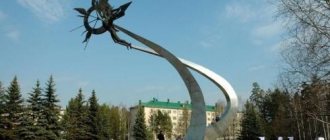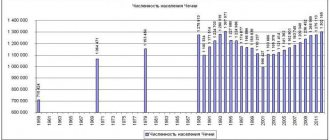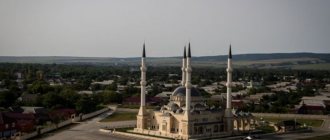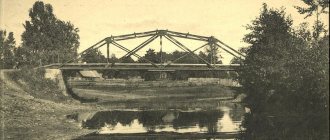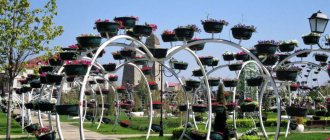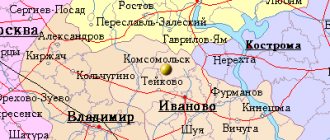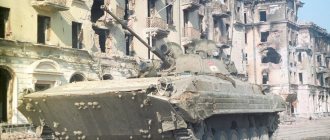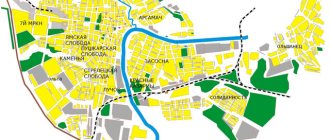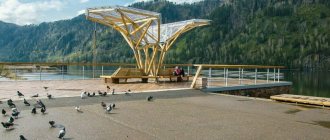For other places with the same name, see Arghun (disambiguation).
City in Chechnya, Russia
| Argun Argun | |
| Town | |
| Other transcription(s) | |
| • Chechen | Ustrada |
| Gadja Aimani Kadyrova Mosque in Argun | |
| Flag Coat of arms | |
| Location of Argun | |
| Argun Location of Argun Show map of Russia Argun Argun (Chechnya) Show map of Chechnya | |
| Coordinates: 43°17′40″N 45°53′02″E / 43.29444°N W. 45.88389°E / 43.29444; 45.88389 Coordinates: 43°17′40″N 45°53′02″E / 43.29444°N W. 45.88389°E / 43.29444; 45.88389 | |
| A country | Russia |
| Federal subject | Chechnya |
| Height | 116 m (381 ft) |
| population size (2010 Census) [1] | |
| • General | 29 525 |
| • Evaluate (2018) [2] | 37 373 ( + 26,6% ) |
| Administrative status | |
| • Subordinate | city of republican significance Argun [3] |
| • Capital from | city of republican significance Argun [3] |
| Municipal status | |
| • Urban district | Argun urban district [4] |
| • Capital from | Argun urban district [4] |
| Timezone | UTC+3 (MSK[5]) |
| Postal code [6] | 366281–366287, 366310 |
| OKTMO ID | 96702000001 |
Argun
(Russian: Аргҁн, pronounced [rˈgun]), also known as
Ustrada
(Chechen: Ustrada or
Orga-Gala
Chechen: Orga-GӀala) is a city in the Chechen Republic, Russia, located on the Argun River. Population: 29,525 (2010 census); [1] 25,698 (2002 census); [7] 25,491 people (1989 census); [8] 22000 (1968).
In April 2022, the independent Russian newspaper Novaya Gazeta documented that Chechen authorities had created so-called "gay concentration camps" in the city. [9]
Argun city
At the entrance to Argun we crossed the river of the same name.
The city of Argun suffered greatly during the Chechen war. Now it mainly consists of the private sector, but there are also new five-story buildings.
The central streets look well-maintained.
Imitation of a Chechen battle tower.
There is also an advertisement on the walls for the Terek football club, renamed Akhmat.
Map
| Argun: maps |
Argun: photo from space (Google Maps) Argun: photo from space (Microsoft Virtual Earth)
| Argun. Nearest cities. Distances in km. on the map (in brackets along roads) + direction. Using the hyperlink in the distance , you can get the route (information courtesy of the AutoTransInfo website) | |||
| 1 | Komsomolskoe | 5 () | SW |
| 2 | Mesker-Yurt | 6 () | SE |
| 3 | Jalka | 10 () | IN |
| 4 | Tsotsi-Yurt | 12 () | SE |
| 5 | Chechen-Aul | 12 () | SW |
| 6 | Germenchuk | 13 () | YU |
| 7 | Gikalo | 13 () | SW |
| 8 | Grozny | 13 (15) | Z |
| 9 | Geldagan | 16 () | SE |
| 10 | Shawls | 16 (16) | YU |
| 11 | Tolstoy-Yurt | 17 () | NW |
| 12 | Authors | 18 () | SE |
| 13 | Ilshan-Yurt | 19 () | IN |
| 14 | New Atagi | 19 () | YU |
| 15 | Gudermes | 19 (22) | IN |
| 16 | Kurchaloy | 20 () | SE |
| 17 | Starye-Atagi | 22 () | SW |
| 18 | Serzhen-Yurt | 22 () | SE |
| 19 | Scarlet | 22 (27) | WITH |
| 20 | Myrtup | 24 () | SE |
| 21 | Alkhan-Yurt | 25 () | Z |
| 22 | Goyty | 25 () | SW |
| 23 | Chiri-Yurt | 25 () | SW |
| 24 | Alkhan-Kala | 27 () | Z |
| 25 | Bachi-Yurt | 28 () | IN |
| 26 | Pervomayskaya | 29 () | Z |
| 27 | Kulary | 30 () | Z |
| 28 | Oyskhara | 31 () | IN |
| 29 | Duba-Yurt | 31 () | YU |
| 30 | Urus-Martan | 31 (44) | SW |
a brief description of
Located on the Chechen (Grozny) foothill plain, on the river. Argun (right tributary of the Sunzha river, Terek basin). Railway station.
Damaged as a result of hostilities.
Territory (sq. km): 28
Information about the city of Argun on the Russian Wikipedia site
Historical sketch
The original Chechen name of the village is Ustar-Gardoy, where Ustar is the Turkic “master, gunsmith”, gardoy is the name of one of the brands of blade, i.e. in general: “masters who forge blades with a guard.”
After the liquidation of the Chechen Autonomous Soviet Socialist Republic, the aul was turned into the village of Kolkhoznoye, and after the restoration of the republic - into the working village of Argun along the river. Argun (from the ethnonym Arg), on which it is located.
PGT since 1962, city since 1967.
Economy
Argun is an industrial suburb of Grozny.
Plant for the production of equipment for the food industry, sugar factory. Meat processing plant. House-building plant.
| Population by year (thousands of inhabitants) | |||||||
| 1970 | 15.1 | 2005 | 26.9 | 2012 | 30.6 | 2018 | 37.4 |
| 1979 | 21.7 | 2006 | 28.1 | 2013 | 32.1 | 2019 | 38.2 |
| 1989 | 25.5 | 2007 | 29.1 | 2014 | 33.2 | 2020 | 39.3 |
| 1992 | 27.6 | 2008 | 40.1 | 2015 | 34.1 | 2021 | 40.3 |
| 1996 | 23.4 | 2010 | 42.8 | 2016 | 35.7 | ||
| 2003 | 25.7 | 2011 | 29.5 | 2017 | 36.5 | ||
Argun City
Probably in every city in Chechnya there is a complex of tall buildings, sort of local skyscrapers. This has become a signature feature of the Republic of Chechnya. Argun City is a complex of 21 storey, 16 storey and 12 storey buildings.
Argun City includes residential buildings, office space and a shopping and entertainment center with shops, cafes and a cinema.
Crescent with a star.
The restaurant in Argun City is located on the 21st floor, who loves panoramic views can visit. There is also a hotel in Argun City with panoramic windows where you can stay.
Climate[edit]
Argun has a humid continental climate (Köppen climate classification: Dfa
).
| Climate data for Argun | |||||||||||||
| Month | Jan | Feb | Mar | Apr | May | Jun | Jul | Aug | Sep | October | But I | December | Year |
| Average high °C (°F) | 1,1 (34,0) | 2,8 (37,0) | 8,4 (47,1) | 17,5 (63,5) | 23,5 (74,3) | 27,8 (82,0) | 30,4 (86,7) | 29,9 (85,8) | 24,5 (76,1) | 16,7 (62,1) | 9,3 (48,7) | 3,4 (38,1) | 16,3 (61,3) |
| Daily average °C (°F) | -2,3 (27,9) | -1,0 (30,2) | 4,0 (39,2) | 11,6 (52,9) | 17,5 (63,5) | 21,8 (71,2) | 24,5 (76,1) | 23,9 (75,0) | 18,8 (65,8) | 11,7 (53,1) | 5,6 (42,1) | 0,4 (32,7) | 11,4 (52,5) |
| Average low °C (°F) | -5,6 (21,9) | -4,8 (23,4) | -0,3 (31,5) | 5,7 (42,3) | 11,6 (52,9) | 15,9 (60,6) | 18,7 (65,7) | 17,9 (64,2) | 13,1 (55,6) | 6,8 (44,2) | 1,9 (35,4) | −2,6 (27,3) | 6,5 (43,8) |
| Average precipitation, mm (inches) | 22 (0,9) | 23 (0,9) | 23 (0,9) | 34 (1,3) | 58 (2,3) | 71 (2,8) | 55 (2,2) | 43 (1,7) | 37 (1,5) | 31 (1,2) | 28 (1,1) | 24 (0,9) | 449 (17,7) |
| Source: [10] | |||||||||||||
Mosque named after Aimani Kadyrova in Argun
Across the road opposite the Argun City business center is the Aimani Kadyrova Mosque. This is the mosque of the mother of Ramzan Kadyrov and the wife of the first and mother of the second president of the Chechen Republic. If the mosque in Grozny is known as the “Heart of Chechnya,” then the mosque in Argun is also known as the “Heart of the Mother.”
In front of the mosque there is a fountain in the form of a shell. Unfortunately, I was never able to find it working.
Exterior view of the Kadyrova mosque
The mosque named after Aimani Kadyrova is made in a modern style. Some Muslims don't like it, but the mosque looks very impressive.
The Aimani Kadyrova Mosque was built according to the design of a Turkish architect. Construction was completed in 2014.
The height of the mosque's dome is 23 meters.
This is not the largest, but it is undoubtedly the most beautiful and unusual mosque I have ever seen.
Three minarets 55 meters high rise above the mosque.
Inner courtyard of the mosque in Argun
The area of the territory occupied by the mosque named after Aimani Kadyrova is 24 thousand square meters. The mosque has a large courtyard.
It’s not even a courtyard; there’s a small park on the inside. There is a pond in it, swans swim.
There are also many flower beds and a greenhouse. If I understand correctly, vegetables are grown in them, which are then used for cooking. The mosque has a canteen where those in need can eat.
LiveInternetLiveInternet
The Argun River, on which the modern city of Argun stands, is a unique attraction. The landscape itself is unique. Rocks, narrow paths, beautiful views make tourists come here again and again. Of course, the “Evil Nineties” cooled the ardor of travelers. Nowadays, few people want to walk along the mountain paths along Argun. But times are changing, the old life in Chechnya is gradually getting better, and I want to believe that in the very near future, the trails along the Argun will become as safe for tourists as they were before. After all, the code of Chechen hospitality will never allow you to offend a guest. There is even a proverb in Argun that says that the insult of a foreigner and a non-religious person is even more sinful than the insult inflicted on a Muslim, since after death Muslims can meet in the next world and sort things out, but such a meeting with a non-religious person will never happen. That is why I would like to hope that soon tourists will be able to fully enjoy the majestic pictures of the Argun landscape.
In addition, it is worth noting that the valleys and rocks through which the Argun flows are inhabited by animals that can only be found here. And researchers of the flora of the Argun valleys have found more than one hundred and fifty species of unique plants that are on the verge of extinction. To preserve this heritage, the “Red Book of Chechnya” was published in 2008, which included endangered species of plants and animals.
Argun is a national treasure that needs protection and protection.
The indigenous population of Argun are the Chechens, who trace their history back to the Vainakhs, a legendary people who once inhabited the Caucasus, Mesopotamia, Asia Minor and Syria. Once upon a time, the Vainakhs were a very numerous people, and according to the legends that have come down to us, it is believed that these people came from the south. The Vainakhs settled unoccupied lands. Their first ruler was Caucasus. From this name came the name of the entire region. At the turn of the second millennium BC, this ancient people settled throughout the Caucasus, Asia Minor, Syria and gradually dissolved among the local population. Only certain Vainakh tribes retained their identity. From them came modern peoples: Chechens, Akins, Ingush, Batsbis, Kists, Orstkhois. Chechens living in Argun call themselves Nokhchi.
Nokhchiy - this is what the Chechens call themselves - the original inhabitants of Argun. The Nokhchi people have long settled along the banks of the Argun River. These people preferred to live in large family communities. One aul, as a rule, consisted of several such communities. Nokhchi dwellings are amazing stone structures built on rocks. Why did these people choose seemingly inconvenient places such as rocks for housing? The answer is quite simple. In the Nokhchi settlement areas there are practically no places with fertile land. That is why the mountaineers settled on the rocks, using any piece of land, even one that was hardly suitable for cultivation.
The houses were built of stone and stood on stones. Even the dead were not buried in the ground, but family crypts were made. Quite a lot of such structures have been preserved in the Argun Nature Reserve. The Argun people themselves had and continue to have a proverb that a living Chechen needs a stone tower to live, and a dead Chechen needs a stone crypt. Everything starts with stones, lives on stones and goes into stones.
The very first residential buildings in the Argun Valley can be dated back to the 11th century. These are, as a rule, the remains of military towers with two purposes: watchtowers and signal towers. The watchtowers on the second tier housed living quarters. The towers of this era are wider in relation to later buildings, they have a square base and four tiers in height, the roofs of these first buildings were flat, and the slope of the walls was gentler than those of the towers built several centuries later.
The crypts were built according to the tower principle. They also had a square base and a flat roof. The inhabitants of the village found their last peace in the crypts. Each clan had its own crypt. During the years of epidemics, everyone who considered themselves sick went to their ancestral crypts and remained near the crypt until God called the unfortunate people to himself or until healing occurred. In this case, it was possible to return to your native village and continue to live as before.
The stone architecture of the ancient people is amazing in its enchanting prostate, uniquely combined with the mountain landscape, high blue sky and an eagle soaring in the skies! Each tower is a story frozen in stone.
For many centuries, the ancient Spring Festival, which has pagan roots, has been celebrated. It has long been celebrated on the day of the vernal equinox (March 22). As in ancient times, so now the women of Argun prepare for this holiday: they clean the house and yard, whitewash the walls, polish copper utensils. Once upon a time, it was necessary to take it outside - into the sun, so that the brightly glowing copper would attract Spring more quickly. On the day of the spring equinox, the whole family got up before dawn to meet the first rays of the rising sun on the porch of their house and thereby, as it were, welcome spring, in the hope that it would generously bestow a rich harvest, health and longevity.
The holiday of welcoming spring is associated with such a pagan rite as going out into the field of the plow. Spring is the time to start sowing. The first furrow is the guarantee of a new harvest. To draw this furrow, the strongest, luckiest and most virtuous man was chosen from the village. It was believed that the gods, having noticed all its positive qualities, would give a bountiful harvest. This ritual was performed on the fourth day of the Spring Festival. The ox that would plow the first furrow was dressed up, decorating the horns with scarlet ribbons and lubricating them with oil. A ribbon was also tied to the tip of the tail. Such a plowman had to be met by his wife, and with full buckets of water. The plow-out celebration did not end there. After the ceremony, the feast began, and on the second day the races began.
Inside the Aimani Kadyrova mosque
The inside of the mosque is no less beautiful. The capacity is designed for 15,000 people. The mosque is open to everyone, the main thing is to follow the rules of visiting and dress code. Taking photos inside the mosque is allowed, but you should not disturb the believers and take pictures of them; depicting people is prohibited in Islam.
Minbar - from here the imam reads his sermon.
Mihrab.
The dome of the mosque is decorated with Arabic script glorifying Allah.
I've never seen chandeliers like these.
The carpet inside the mosque is woven in one piece. But just imagine how long it takes to vacuum it?
On the second floor, through the windows inside the mosque you can see Argun City.
After spending about 45 minutes on Argun and the Aimani Kadyrova Mosque, we went further through the Republic of Chechnya towards Grozny. I will tell you about Grozny in the near future.
Population[ | ]
| Population | ||||||
| 1970[9] | 1979[10] | 1989[11] | 1996[12] | 2002[13] | 2003[12] | 2005[12] |
| 15 148 | ↗21 652 | ↗25 491 | ↘23 400 | ↗25 698 | ↗25 700 | ↗26 900 |
| 2007[12] | 2008[12] | 2009[14] | 2010[15] | 2011[16] | 2012[17] | 2013[18] |
| ↗29 100 | ↗40 100 | ↗41 767 | ↘29 525 | ↘29 500 | ↗30 647 | ↗32 058 |
| 2014[19] | 2015[20] | 2016[21] | 2017[22] | 2018[23] | 2019[24] | 2020[25] |
| ↗33 207 | ↗34 078 | ↗35 738 | ↗36 486 | ↗37 373 | ↗38 169 | ↗39 275 |
| 2021[1] | ||||||
| ↗40 290 | ||||||
As of January 1, 2022, in terms of population, the city was in 382nd place out of 1116[26]cities of the Russian Federation[27].
National composition
The ethnic composition of the city’s population according to the 2010 All-Russian Population Census[28]:
| People | Number of people, people | Share of the total population, % |
| Chechens | 29 323 | 99,32 % |
| other | 161 | 0,54 % |
| not specified | 41 | 0,14 % |
| Total | 29 525 | 100,00 % |
Status[ | ]
Urban district of Argun on the map of the Chechen Republic
The city is an administrative-territorial unit (city of republican significance)[29][30] and a municipal entity, endowed with the status of an urban district by Law of the Chechen Republic No. 15-rz dated February 20, 2009 “On Education municipal formation of the city of Argun, establishing its borders and giving it the status of an urban district"[31][32]. The concept of “urban district of Argun”
and
“city of Argun”
are equivalent.[31]
From January 1, 2022, the territories of Komsomolsky (the village of Komsomolskoye and the village of Primykanye) and Chechen-Aulsky rural settlements (the village of Chechen-Aul)[33], the area of which after that is 130, were transferred from the Grozny district to the urban district of Argun. ,21[34] km².
The mayor of the city is Masaev Iles Akhmedovich[35].
The head of the city (Chairman of the Council of Deputies of the city of Argun) since August 30, 2022 is Ayubov Ibragim Zilimkhanovich[36].
Notes[ | ]
- ↑ 12
The permanent population of the Russian Federation by municipalities as of January 1, 2022 (Russian). Retrieved April 27, 2022. Archived May 2, 2022. - A.G. Matsiev, A. T. Karasaev - Russian-Chechen dictionary. - Russian language, 1978. - 728 p.
- Suleymanov A. Toponymy of Chechnya. Grozny: State Unitary Enterprise “Book Publishing House”, 2006
- Pospelov, 2008, p. 42.
- Passport of the municipality of the urban district of Argun (undefined)
. - Abazatov, 1962, p. 121.
- ON CHANGES IN THE ADMINISTRATIVE-TERRITORIAL DIVISION OF THE RSFSR // Gazette of the Supreme Council of the RSFSR. - 1962. - December 30 (No. 52).
- Lom-Ali Kosumov.
In Argun, the opening of the Aimani Kadyrova mosque and the Argun City high-rise building complex
(unspecified)
(inaccessible link). www.groztrk.net. Access date: September 11, 2015. Archived March 4, 2016. - All-Union Population Census of 1970 The size of the urban population of the RSFSR, its territorial units, urban settlements and urban areas by gender. (Russian). Demoscope Weekly. Access date: September 25, 2013. Archived April 28, 2013.
- All-Union Population Census of 1979 The size of the urban population of the RSFSR, its territorial units, urban settlements and urban areas by gender. (Russian). Demoscope Weekly. Access date: September 25, 2013. Archived April 28, 2013.
- All-Union population census of 1989. Urban population (undefined)
. Archived from the original on August 22, 2011. - ↑ 12345
People's encyclopedia "My City". Argun (city) - All-Russian population census 2002. Volume. 1, table 4. Population of Russia, federal districts, constituent entities of the Russian Federation, districts, urban settlements, rural settlements - regional centers and rural settlements with a population of 3 thousand or more (unspecified)
. Archived from the original on February 3, 2012. - The size of the permanent population of the Russian Federation by cities, urban-type settlements and regions as of January 1, 2009 (unspecified)
. Retrieved January 2, 2014. Archived January 2, 2014. - All-Russian population census 2010. Volume 1. Number and distribution of the population of the Chechen Republic (undefined)
. Access date: May 9, 2014. Archived May 9, 2014. - Number of urban settlements in the Chechen Republic as of January 1, 2011 (unspecified)
. Access date: May 11, 2016. Archived May 11, 2016. - Population of the Russian Federation by municipalities. Table 35. Estimated resident population as of January 1, 2012 (unspecified)
. Retrieved May 31, 2014. Archived May 31, 2014. - Population of the Russian Federation by municipalities as of January 1, 2013. - M.: Federal State Statistics Service Rosstat, 2013. - 528 p. (Table 33. Population of urban districts, municipal districts, urban and rural settlements, urban settlements, rural settlements) (undefined)
. Retrieved November 16, 2013. Archived November 16, 2013. - Table 33. Population of the Russian Federation by municipalities as of January 1, 2014 (unspecified)
. Access date: August 2, 2014. Archived August 2, 2014. - Population of the Russian Federation by municipalities as of January 1, 2015 (unspecified)
. Access date: August 6, 2015. Archived August 6, 2015. - Population of the Russian Federation by municipalities as of January 1, 2016 (Russian) (October 5, 2018). Retrieved May 15, 2022. Archived May 8, 2022.
- Population of the Russian Federation by municipalities as of January 1, 2022 (Russian) (July 31, 2017). Retrieved July 31, 2022. Archived July 31, 2022.
- Population of the Russian Federation by municipalities as of January 1, 2022 (Russian). Retrieved July 25, 2018. Archived July 26, 2022.
- Population of the Russian Federation by municipalities as of January 1, 2022 (Russian). Retrieved July 31, 2019. Archived May 2, 2022.
- Population of the Russian Federation by municipalities as of January 1, 2022 (Russian). Date accessed: October 17, 2022. Archived October 17, 2022.
- taking into account the cities of Crimea
- https://rosstat.gov.ru/storage/mediabank/bul_Chislen_nasel_MO-01-01-2021.rar Population of the Russian Federation by municipalities as of January 1, 2022 (1.85 Mb, 07/30/2021)
- Volume 4 book 1 “National composition and language proficiency, citizenship”; table 1 “National composition of the population of Chechnya by urban districts, municipal districts, urban settlements, rural settlements with a population of 3000 people or more” (undefined)
(inaccessible link). Access date: January 3, 2014. Archived September 29, 2015. - Law “On the administrative-territorial structure of the Chechen Republic”. (Russian). docs.cntd.ru.
_ Access date: February 17, 2022. - Constitution of the Chechen Republic (Russian). docs.cntd.ru.
_ Access date: February 17, 2022. - ↑ 1 2
Charter of the municipal formation of the city of Argun of the Chechen Republic (Russian).
newargun.ru
. Access date: February 17, 2022. - Law “On the formation of the municipality of the city of Argun, establishing its borders and granting it the status of an urban district” dated February 20, 2009 N 15-RZ. (Russian). docs.cntd.ru.
_ Access date: February 17, 2022. - Law of the Chechen Republic of October 4, 2022 N 41-RZ “On the transformation, changes in the boundaries of individual municipalities of the Chechen Republic and amendments to some legislative acts of the Chechen Republic” (Russian). docs.cntd.ru.
_
Date of access: February 17, 2022. (full version of the text.pdf (Russian). parlamentchr.ru
. Date of access: February 17, 2022.) - Law of the Chechen Republic of October 4, 2022 N 41-RZ “On the transformation, changes in the boundaries of individual municipalities of the Chechen Republic and amendments to some legislative acts of the Chechen Republic” (Russian). parliamentchr.ru
. Date of access: February 17, 2022. - P. 3393 - Mayor of Argun (Russian). newargun.ru
. Access date: February 17, 2022. - Head of the city (Russian). sovetargun.ru
. Access date: February 17, 2022.
